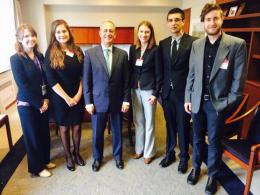Editor’s Note: This post was written by Ohio University junior Luke Kubacki. Luke is the Campaigns Coordinator for STAND, the student-led movement to end mass atrocities, and was also a participant in the Lemkin Summit in February 2015.

In the day-to-day of campus life, it’s so easy to lose sight of the something greater. This is especially hard for me as I go to school in a small town where the university is really the only thing around. My time is divided between class, Donkey Coffee on Washington Street, and the Smiling Skull bar on Union. Of course, as a student, my mind is divided as many ways as it can be between class, reading, papers, projects, summer, food, bills, work, money (money, money).
From the students that I’ve talked to, this is a very familiar slump that most of us experience. Even if we love what we study and enjoy the work we do, it’s so hard to maintain this double vision, a balance between the work that’s necessary now and the work that’s necessary for the something greater.
Last month, the Lemkin Summit pulled 110 of us out of this slump and gave us an opportunity to focus on this greater something: the movement to end genocide and mass atrocities. As I drove away from Athens towards DC with four other student activists from around Ohio and Michigan, I felt the excitement of this shared vision. Over the next three days, we explored this vision through educational sessions and trainings, then presented it to the elected representatives in Washington.
I was profoundly inspired and motivated by two things. The first was the work being done by active students across the country. The opportunities to connect with fellow students were full of conversations about the failures and successes of different campaigns on campus. We exchanged strategies and discussed the different trainings in which we were participating. But, more importantly, we were able to connect on a personal level. We talked about the difficulties of balancing the demands of the everyday and the pull of the vision we shared. We talked about the disappointment we feel after no one participates in a campaign or when 9 people populate a room for 200. I saw the struggle that I experienced so often was shared across the country. I felt the movement.
The second thing that profoundly inspired me was the work being done by professionals in DC. A small group of us met with Special Envoy Russ Feingold who has served as the U.S. Special Envoy to the Great Lakes Region of Africa (which consists of Uganda, DRC, Burundi,Tanzania, Kenya, and Rwanda) and the Democratic Republic of Congo for the past two years. Special Envoy Feingold, who announced the week before that he would be stepping down from his position, sat with us and shared candidly the diplomatic difficulties, failures, and successes of the past two years. I saw the common vision we had shared over the weekend in a State Department office. I heard it in Feingold’s voice as he told us that the genocide and mass atrocity prevention successes over the past 15 years would not have been possible without the student voice and without the student body filling public spaces to advocate for the voiceless. I felt the movement.
I remember writing letters, making phone calls, tabling outside of the student union, and posting all over everybody’s social media for the creation of Russ Feingold’s position my freshman year. To see that come in a full circle and hear him talk about the peace we moved towards was eye opening. The slump from which we all operate felt a bit more meaningful and the maintenance of that shared vision felt a bit more possible. Over one hundred of us left DC ready to use our new tools and share the vision. We felt the movement.
Photo: Luke Kubacki (far right) joins a group of Lemkin Summit participants and Enough Project staff in a a meeting with Special Envoy Russ Feingold.

